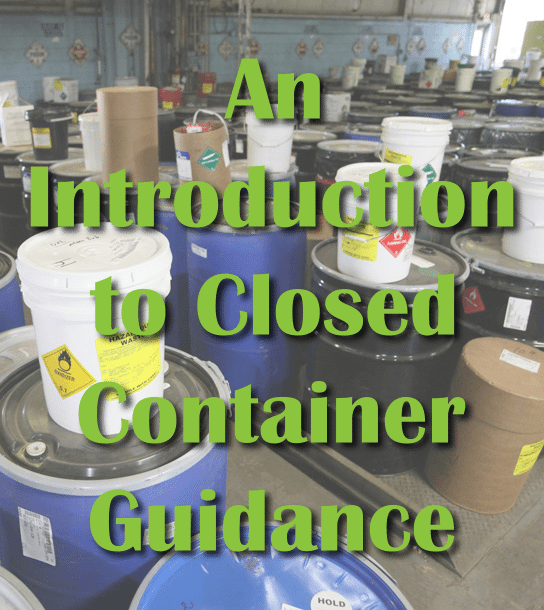
In December of 2009 the EPA issued guidance for both Large Quantity and Small Quantity Generators concerning how to decide when a container is “closed.” The guidance is pertinent whether waste is being accumulated in central accumulation areas (CAA) or satellite accumulation areas (SAA) or at RCRA permitted interim facilities. Today we will be providing an overview of this EPA guidance but keep reading in coming weeks for more in-depth looks at guidelines for specific storage areas and container types.
To begin we need to understand that the EPA defines a container as “any portable device in which a material is stored, transported, treated, disposed of, or otherwise handled.” The regulations in 40 CFR 265 require containers that are holding hazardous waste to be closed during storage and open only when adding or removing waste. Additionally, it stipulates that containers must not be opened, stored, or handled in a way that would cause the container to rupture or leak.
Typically, like in the case of 55 gallon drums, the EPA recommends that a container cover is, “properly secured with snap rings tightly bolted, bungholes capped, and, where appropriate, pressure-vacuum relief valves to maintain the containers internal pressure and avoid explosions.”
A container accumulating free liquids or liquid hazardous waste is considered closed when all openings or lids are properly and securely affixed to the container unless waste is being added or removed from said container. A container holding solid or semi-solid hazardous wastes is closed when, “there is complete contact between the lid and the rim all around the top of the container.” Generally speaking, the EPA considers a container closed when it is, “sealed to the extent necessary to keep the hazardous waste and associated air emissions inside the container.”
The reasoning behind the closed container guidelines is explained in the preamble to the final rule created in 1980. It states:
“…Its purpose is, as it was originally, to minimize emissions of volatile wastes, to help protect ignitable or reactive wastes from sources of ignition or reaction, to help prevent spills, and to reduce the potential for mixing of incompatible wastes and direct contact of facility personnel with waste. While many commenters argued and the Agency agrees that storage may properly be conducted in open tanks and surface impoundments, requiring containers to be kept closed does not unnecessarily restrict storage options. All containers have lids or some other closure device, and keeping containers closed whenever possible is simply a matter of good operating practice. It is not expected that containers of hazardous waste need be opened routinely to inspect the waste or the container for reasons other than to add or remove waste.”
What this means is that you can view container regulations as akin to performance standards intended to minimize the risk for potential spills, leaks, or air emissions. So remember to keep your containers closed. If you have tips or strategies let us know in the comments!
Quoted and cited information (unless otherwise noted) for this blog post was gathered from the EPA Memorandum on Closed Containers. As always, this blog post is not intended to be comprehensive and it is always best to check with the EPA and local government for full, up-to-date, rules and regulations.
More News From Heritage
-
Published Articles 8/2/22
How Safety, Maintenance, and Reliability Are Intertwined
VP of Health and Safety Jim Mangas discusses the importance of plant safety, maintenance, and reliability (featured in BIC Magazine July/Aug '22)
-
Blogs 7/28/22
Spotlighting Our Environmental Interns
Highlighting some of the wonderful interns we have at Heritage this year!
-
Blogs 7/11/22
Turning Hazardous Waste into an Alternative Fuel
In this blog we walk you through the process of fuel blending, where we can turn hazardous waste materials into a viable alternative fuel source.
-
Community News 6/15/22
2022 Habitat for Humanity Build
Our 12th annual Habitat for Humanity Build
-
Blogs 4/13/22
After Hurricane Ida, Our Port Fourchon Office Rebuilds
On August 28th, 2021, the Louisiana coast was battered by Hurricane Ida. This included our Port Fourchon Service Center, where the devastating hurrica
-
Community News 4/7/22
Heritage readies for Earth Day HHW collection in East Liverpool
Heritage Thermal Services is pleased to announce that its collection of household hazardous wastes for the East Liverpool area returns for 2022.
-
Published Articles 4/2/22
The Impact of Changing Conditions
VP of Health and Safety Jim Mangas discusses preparedness for unexpected conditions during a project. (featured in BIC Magazine March/April '22)
-
Blogs 3/11/22
International Women’s Week Spotlight – Rachel McGrogan
Rachel McGrogan speaks about her time as a Lab Chemist at Heritage.








